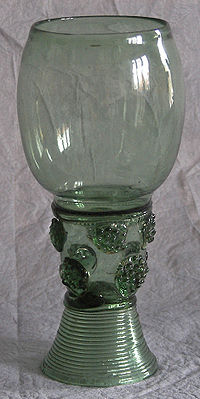Nuppen
In glass production, nubs are small batches of glass that are placed on the base, shaft or wall of the vessel in the form of drops. Depending on the twisting and stamping technique of the glass plug, different shapes were created in this way, for example snail patterns, rosettes , shapes drawn upwards or pressed several times with stamps so that a raspberry or blackberry-like appearance of the drop was achieved; in this case one speaks of berry soups .
Bump glasses are those glass vessels that have such bumps as the sole and thus characterizing form of decoration. The technique has been known since ancient times and has been used in all epochs of glass history.
history
Nuppe glasses were mostly used as simple glass for use as early as the Roman Empire . While numerous glasses with nubs in two to four different colors (mostly yellow, green, brown, blue and red) were found in the three western Roman provinces of Germania superior , Germania inferior and Gallia Belgica , the nub glasses in Byzantium were mostly monochrome blue. Among the preserved late Roman Nuppe glasses there are a few examples of high artistic quality.
Presumably through the trade with Byzantium, the Syrian and Islamic beaded glass, which is in the tradition of Eastern Rome, came to the Republic of Venice , whose glassmakers, according to early sources, were able to produce their own beaded bead cups as early as the 13th century. However, this tradition dried up in the late Middle Ages. Nothing has survived from the early glass, and the thin-walled, colorless Venetian cristallo , which flourished later in the Renaissance and which also came to Central Europe as glass à la façon de Venise from the late 16th century, is characterized by refined styles.
The second development path taken by Central European glass production is more important for the further spread of Nuppe glass: the thick-walled, inevitably green glass for use in the forest glassworks north of the Alps, presumably based on relics of Franconian know-how, knew the Nupp decor from From the beginning. The rough protuberances on Franconian proboscis could have served as models. Shaped glass with simple nubs was already widespread throughout Germany and the Netherlands in the 14th and 15th centuries ( Nuppenbecher ).
Around 1500 the so-called Krautstrunk was created , a cup, the wall of which was covered with thick, snail-shaped knobs, which gave the vessel a cabbage-like appearance. In the 16th century, the herb drink became the Berkemeyer with smooth walls; There are nubs here only on the foot with a shaft-like extension upwards. At the same time in Bohemia there were tall, slender rod glasses, thin-walled and with very small nubs. The Berkemeyer is the forerunner of the Roman , which in its original - baroque - form of the 17th and 18th centuries still belongs to the forest glass and always had berry nubs on the shaft as a constitutive style element. In the case of the Romans of historicism , however, these berry soups may be missing or, contrary to tradition, they may be attached elsewhere than on the shaft.
In the history of glass in later epochs, nubs still occasionally appear as a stylistic element, but no longer as the sole characterizing form of decoration; in this respect one no longer speaks of the Nuppenglas. Nevertheless, colorful nubs in the shape of drops occasionally decorate Art Nouveau and Art Deco vessels .
literature
- Sabine Baumgärtner : Glass art from the Middle Ages to Classicism. Bremer Landesmuseum, Focke-Museum, inventory catalog 1987 (= booklets of the Focke-Museum. No. 76, ZDB -ID 17580-8 ). Bremen State Museum, Focke Museum, Bremen 1987.
- Michael J. Klein (Ed.): Roman glass art and wall painting. von Zabern, Mainz 1999, ISBN 3-8053-2597-5 .
